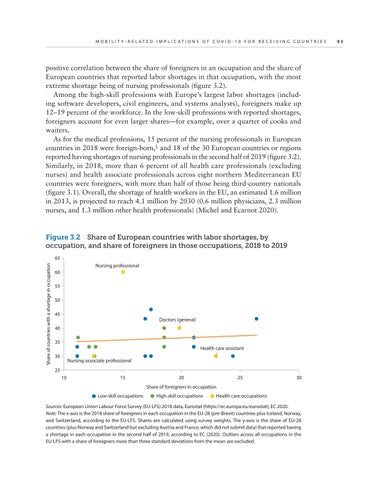M o b i l i t y - R e l a t e d Im p l i c a t i o n s o f CO V ID - 1 9 f o r R e c e i v i n g C o u n t r i e s
positive correlation between the share of foreigners in an occupation and the share of European countries that reported labor shortages in that occupation, with the most extreme shortage being of nursing professionals (figure 3.2). Among the high-skill professions with Europe’s largest labor shortages (including software developers, civil engineers, and systems analysts), foreigners make up 12–19 percent of the workforce. In the low-skill professions with reported shortages, foreigners account for even larger shares—for example, over a quarter of cooks and waiters. As for the medical professions, 15 percent of the nursing professionals in European countries in 2018 were foreign-born,1 and 18 of the 30 European countries or regions reported having shortages of nursing professionals in the second half of 2019 (figure 3.2). Similarly, in 2018, more than 6 percent of all health care professionals (excluding nurses) and health associate professionals across eight northern Mediterranean EU countries were foreigners, with more than half of those being third-country nationals (figure 3.1). Overall, the shortage of health workers in the EU, an estimated 1.6 million in 2013, is projected to reach 4.1 million by 2030 (0.6 million physicians, 2.3 million nurses, and 1.3 million other health professionals) (Michel and Ecarnot 2020).
Figure 3.2 Share of European countries with labor shortages, by occupation, and share of foreigners in those occupations, 2018 to 2019 Share of countries with a shortage in occupation
65 Nursing professional 60 55 50 45
Doctors (general)
40 35
Health care assistant
30
Nursing associate professional
25 10
15
20
25
30
Share of foreigners in occupation Low-skill occupations
High-skill occupations
Health care occupations
Sources: European Union Labour Force Survey (EU-LFS) 2018 data, Eurostat (https://ec.europa.eu/eurostat); EC 2020. Note: The x-axis is the 2018 share of foreigners in each occupation in the EU-28 (pre-Brexit) countries plus Iceland, Norway, and Switzerland, according to the EU-LFS. Shares are calculated using survey weights. The y-axis is the share of EU-28 countries (plus Norway and Switzerland but excluding Austria and France, which did not submit data) that reported having a shortage in each occupation in the second half of 2019, according to EC (2020). Outliers across all occupations in the EU-LFS with a share of foreigners more than three standard deviations from the mean are excluded.
9 5

